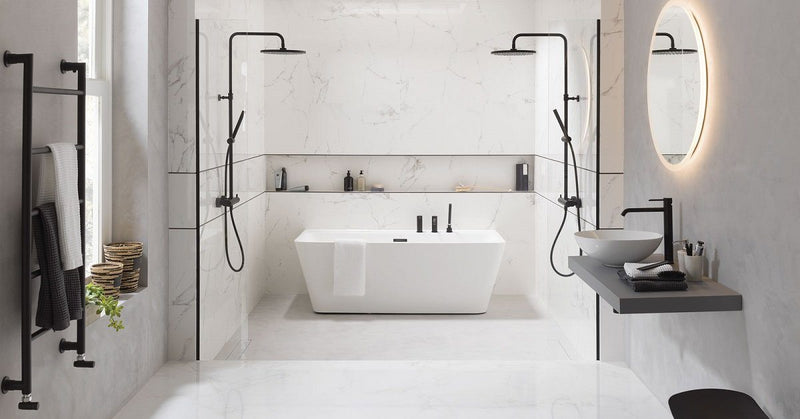
How Water-Saving Toilets Work: A Deep Dive into Tech
Share
In our ever-evolving world, where technology continuously redefines everyday life, the bathroom has not been left behind. One fascinating innovation in this space is the water-saving toilet. As tech professionals and enthusiasts, understanding how these toilets work can give us insights into the broader implications of smart and sustainable living. So, let's dive into the mechanics and technology behind these revolutionary fixtures.
The primary goal of water-saving toilets is to conserve water without compromising performance. With increasing concerns about water scarcity and environmental impact, these toilets play a crucial role in sustainable living. But how exactly do they achieve this? Let's explore.

The Mechanics of Water-Saving Toilets
At the heart of water-saving toilets is the mechanism that controls the flush volume. Traditionally, toilets used a substantial amount of water per flush, often ranging from 3.5 to 7 gallons. In contrast, modern water-saving toilets can use as little as 1.28 gallons per flush. This significant reduction is made possible through a combination of smart design and advanced technology.
Gravity-Based Systems
One of the simplest yet effective systems is the gravity-based mechanism. These toilets rely on gravity to clear waste, utilizing a carefully designed bowl and trapway that maximizes flush efficiency. The water stored in the tank is released with enough force to push waste through the S-shaped trapway, minimizing the need for excessive water usage.
Pressure-Assisted Systems
For those seeking an even more efficient solution, pressure-assisted systems offer an exciting alternative. By using compressed air within the tank, these toilets provide a powerful flush that requires less water. The pressurized air forces water into the bowl with greater velocity, effectively clearing waste with minimal water usage.
Dual-Flush Technology
An innovation within the realm of water-saving toilets is dual-flush technology. This system provides users with two flushing options: a lower volume flush for liquid waste, and a higher volume flush for solid waste. By allowing users to choose the appropriate flush type, significant water savings can be achieved over time.
To learn more about the advantages of dual-flush systems, you can visit Dual-Flush Toilet Advantages.
Smart and Connected Toilets
As technology continues to advance, the concept of smart toilets is gaining traction. These toilets are equipped with sensors and connectivity features that allow for automatic flushing and water usage monitoring. Some models can even adjust the flush volume based on usage patterns, further optimizing water conservation.
For those interested in the broader implications of smart home technology and sustainable living, check out IoT for Sustainable Community Living.
Installation and Maintenance
While the technology behind water-saving toilets is impressive, proper installation and maintenance are key to ensuring optimal performance. Many homeowners are taking a DIY approach to installation, which can be a cost-effective option. However, understanding the intricacies of the system is crucial for success.
For a guide on DIY installation, visit DIY Water-Saving Toilet Installation.
Benefits Beyond Water Conservation
Beyond the obvious water savings, these toilets offer several additional benefits. By reducing the amount of water used per flush, homeowners can expect lower utility bills. Additionally, the reduced strain on municipal water systems contributes to overall environmental sustainability. Moreover, many water-saving toilets are designed with enhanced aesthetics and comfort in mind, offering a seamless integration into modern bathroom designs.
Choosing the Right Water-Saving Toilet
When selecting a water-saving toilet, several factors must be considered, including the type of flush system, design, and brand reputation. Some of the best brands in the market offer a balance of performance, efficiency, and style.
To explore the top brands for water-saving toilets, you can find more information at Best Brands for Water-Saving Toilets.
Conclusion: The Future of Water-Saving Technology
As our world continues to face water scarcity challenges, the importance of water-saving technologies becomes increasingly evident. Water-saving toilets are a testament to the power of innovation in addressing environmental issues. By embracing these technologies, we can contribute to a more sustainable future.
For additional tips on water conservation at home, consider visiting Home-Water-Works.

Frequently Asked Questions
What is the average water savings with water-saving toilets?
Water-saving toilets can reduce water usage by up to 60% compared to traditional models, potentially saving thousands of gallons per year per household.
Do water-saving toilets compromise on flushing power?
Modern water-saving toilets are designed to provide effective flushing with less water. Technologies like pressure-assisted systems and dual-flush options ensure performance is not compromised.
Are there incentives for installing water-saving toilets?
Many regions offer rebates and incentives for installing water-saving fixtures, making it a financially viable and environmentally responsible choice.
This article contains affiliate links. We may earn a commission at no extra cost to you.
